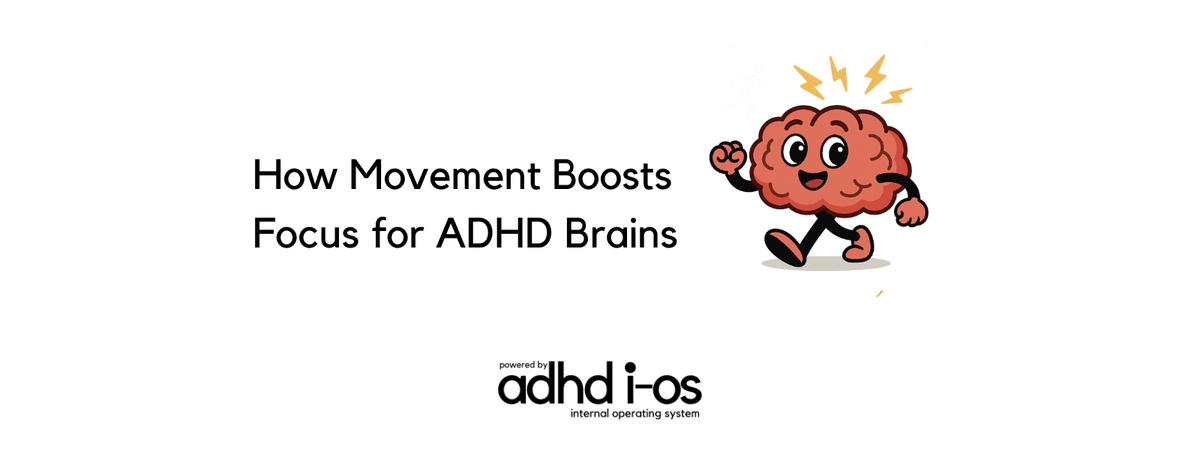How Movement Boosts Focus for ADHD Brains
How Movement Boosts Focus for ADHD Brains
How Movement Boosts Focus for ADHD Brains
Ever try to focus but your brain says “nope” until you… stand up?
You sit down with the best intentions, ready to work, write, read, or think. But your leg starts bouncing. Your pen becomes a fidget toy. Your brain? Still stuck in fog.
Then you get up to stretch, pace, or take a walk. And suddenly, clarity arrives.
For ADHD brains, movement isn’t a distraction. It’s often the doorway into focus. Let’s break down the brain science behind why moving your body helps ADHD brains click into gear, and how you can use it to your advantage.

The Science: Why Movement Changes the ADHD Brain
Physical movement isn’t just good for your body. It literally changes how your brain functions. Here’s how:
Dopamine Activation
ADHD brains often struggle with low or inconsistent dopamine, a key neurotransmitter for attention and motivation. Physical activity (even light movement!) increases dopamine levels, helping your brain “switch on.”
Neuroplasticity & BDNF Boost
Exercise triggers the release of BDNF (brain-derived neurotrophic factor), a protein that supports learning, memory, and focus by strengthening connections between brain cells.
Cortisol Regulation
Movement also helps regulate cortisol, your stress hormone. In ADHD brains – where stress can hijack focus – exercise acts like a natural chill pill, calming the nervous system and reactivating the prefrontal cortex (your brain’s control center).
Why ADHD Brains Benefit More from Movement
- Baseline dopamine is lower. ADHD brains need more stimulation to kick into gear. Movement provides that “starter spark.”
- Sitting still often backfires. Instead of improving focus, stillness may cause more restlessness and disengagement.
- Body movement = brain engagement. The more your body moves, the more alert your brain becomes.
Real-Life ADHD Struggles Movement Can Help With
For many ADHD brains, focus doesn’t show up on demand, especially when stillness is the default. In these situations, movement can act as a powerful reset button:
- Foggy thinking at your desk
- Struggling to get started on a task
- Midday attention crashes
- Feeling emotionally overwhelmed when “trapped” in stillness
Movement resets your brain’s rhythm, offering a fresh start, even mid-meltdown. A few minutes of walking, stretching, or even pacing around your room can help realign your focus, regulate your nervous system, and restart your cognitive rhythm.
This gives your brain the spark it needs to re-engage.
ADHD-Smart Movement Strategies (Backed by Brain Science)
Let’s get practical. Try these simple tools to weave movement into your day:
Strategy - Task Pacing
Why It Helps - Walk while thinking, planning, or making calls keeps the brain engaged while moving.
Strategy - Transition Stretching
Why It Helps - A few seconds of stretching between tasks can reboot focus.
Strategy - Movement Anchors
Why It Helps - Standing desks, wobbly chairs, or bounce balls offer kinetic input while working.
Strategy - Time-Based Boosts
Why It Helps - 5-minute dance breaks or jumping jacks before starting a focus task.
Strategy - Environmental Design
Why It Helps - Create spaces where movement isn’t “fidgeting” but part of how you work.
What the Research Says
- Exercise improves executive function, working memory, and sustained attention in neurodivergent brains.
- A 2023 meta-analysis showed aerobic movement reduces hyperactivity and boosts attention in both kids and adults with ADHD.
- Experts like Dr. John Ratey argue that movement acts like “medication” for the ADHD brain. It is fast-acting, powerful, and natural.
Bottom Line: Movement = Focus Fuel
You don’t need to run a marathon. You just need to move. In ADHD brains, movement isn’t a bonus. It’s a regulation tool.
It’s a way to activate focus, calm the mind, and shift emotional states.
Instead of fighting your need to move… try following it.
Try This Today
Pick one movement strategy, like walking while brainstorming or stretching before a hard task, and try it out.
Then ask yourself: Did my brain feel more awake? More focused? Less stuck?
We want to hear how it goes. And join the adhd i-os community for more science-backed tools that actually match how your brain works…and moves.

